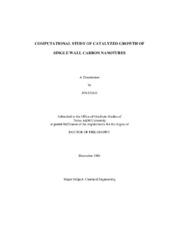| dc.description.abstract | A recently developed chemical vapor deposition (CVD) synthesis process called CoMoCAT yields single-wall carbon nanotubes (SWCNT)s of controlled diameter and chirality, making them extremely attractive for technological applications. In this dissertation, we use molecular dynamics simulations and density functional theory to study the selective growth mechanisms.
In the CoMoCAT process, growth of SWCNTs happens on Co clusters with diameters of about 1 �. Effective force fields for Ni-C interactions developed by Yamaguchi and Maruyama for the formation of metallofullerenes and the reactive empirical bond order Brenner potential for C-C interactions are modified to describe interactions in such system. Classical molecular dynamics (MD) simulations using this force field are carried out to study the growth of SWCNT on floating and supported metal clusters. The effect of metal-cluster interactions on the growth process is discussed. The energy of forming one more ring at the open end of one-end-closed nanotubes with different chiralities, which is believed to be the basic step of nanotube elongation, are studied as a function of tube length. The energy and shape of the frontier highest occupied molecular orbital (HOMO) and lowest unoccupied molecular orbital (LUMO) of armchair nanotubes are studied and used to explain the change of reaction energy with tube length.
Another property, the aromaticity of the rings forming a tube is also studied using Nucleus Independent Chemical Shift (NICS) as probe. NICS of rings in one-end-closed nanotubes with different chirality are studied as a function of tube length. NICS behavior of one-end-closed nanotube is compared with that of two-ends-open nanotube with the same chirality for nanotubes (6, 5) and (9, 1). Also (8, 3) nanotubes with one end open and the other end bonded to three different kinds of cap structures are compared.
Since from both experimental observation and from our MD simulation results, the growth process of SWCNT can be affected by the interaction between Co clusters and their substrate, the performance of a series of CoN Clusters (N=1-4, 7, 10, 14, 15) adsorbed on MoC surface are studied with density functional theory. | en |


